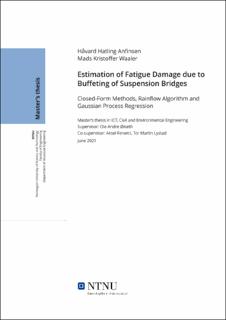| dc.contributor.advisor | Øiseth, Ole Andre | |
| dc.contributor.advisor | Fenerci, Aksel | |
| dc.contributor.advisor | Lystad, Tor Martin | |
| dc.contributor.author | Anfinsen, Håvard Hatling | |
| dc.contributor.author | Waaler, Mads Kristoffer | |
| dc.date.accessioned | 2021-10-21T18:16:31Z | |
| dc.date.available | 2021-10-21T18:16:31Z | |
| dc.date.issued | 2021 | |
| dc.identifier | no.ntnu:inspera:78584794:24721788 | |
| dc.identifier.uri | https://hdl.handle.net/11250/2824681 | |
| dc.description.abstract | I løpet av de siste 50 årene har mange frekvensbaserte metoder for å estimere utmattingsskader blitt presentert. Hovedmålet med denne avhandlingen er å sammenligne noen av de mest populære frekvensbaserte metodene mot rainflow-telling kombinert med den lineære Miners regel. Metodene er testet på realistiske spenningsspektre generert fra vindlaster. Et teoretisk grunnlag presenteres for stokastiske prosesser, Gaussisk prosess regresjon samt utmattingsanalyse. Sammenligningene ble utført på et flerfrihetsgradsystem i form av en skjærramme i stål og en modell av den planlagte Langenuen bru i aluminium. Begge modellene ble utsatt for vindlaster beskrevet gjennom en simultanfordeling mellom middelvindhastighet og standardavviket til turbulensen i vindretningen. Surrogatmodellene ble generert gjennom en oppdateringsprosess hvor punkter ble sekvensielt lagt til i treningsdataen. Til slutt utføres en numerisk integrasjon av surrogatmodellene for å finne utviklingen til utmattingsskaden, som danner grunnlaget for sammenligningen.
Tre ulike modeller av skjærrammen ble analysert med en, tre og fem frihetsgrader. Modellene ble analysert med og uten bakgrunnsrespons for å gi ytterligere variasjoner i spenningsspektrene. I tillegg ble metodene testet på fire ulike SN-kurver for å sammenligne sensitiviteten i forhold til stigningstallet på kurvene. Den relative feilen økte i takt med slakere SN-kurver for alle metoder. Metodene presentert av Dirlik samt Tovo og Benasciutti oppnådde best resultater for skjærrammene med relativ feil mellom 5-35% avhengig av type spenningsspekter. Da bakgrunnsresponsen ble ekskludert i spenningsspektrene estimerte flere metoder ikke-konservative resultater. Single-moment metoden gav generelt lav relativ feil, men viste et tydelig mønster med å produsere ikke-konservative resultater for økt båndbredde.
Forskyvnings og kraftmodene til Langenuen bru ble hentet ut fra en modell i Abaqus. De ulike frekvensbaserte metodene ble testet på spenningsspektre fra to tverrsnittsdetaljer over ni ulike snitt langs brua. Alle metoder produserte ikke-konservative resultater, med unntak av narrow band metoden og metoden presentert av Jiao og Moan som oppnådde estimater med stor relativ feil. Single-moment gav de mest ikke-konservative resultatene hvor utmattingsskaden ble underestimert med opp mot 30%. Metoden utarbeidet av Dirlik i tillegg til metoden fra Tovo og Benasciutti resulterte i en relativ feil rundt 10% for Langenuen bru. De viste seg å gi de mest konsistente estimatene ut ifra alle spenningsspektre som ble analysert i denne avhandlingen. Metodene burde uansett bli brukt med forsiktighet på grunn av uforutsigbare ikke-konservative estimeringer. | |
| dc.description.abstract | Several closed-form methods for calculating accumulated fatigue damage have been proposed in the last 50 years. The primary goal in this thesis is to compare some popular closed-form methods to the rainflow counting algorithm combined with Miner's rule. The methods were tested on realistic stress spectrums generated by buffeting wind loading. A theoretical foundation is presented for stochastic processes, Gaussian process regression and fatigue damage accumulation. The comparisons were performed on multi-degree of freedom systems presented as shear frames in steel and a model of the planned Langenuen bridge in aluminum. Both models were exposed to buffeting wind loading represented by a joint probability distribution between the mean wind velocity and the standard deviation of the turbulence along-wind. Surrogate models were created using an updating approach where points were sequentially added to the training data set. Finally, a numerical integration of the surrogate models was performed to find the rate of fatigue damage accumulation for each method, which is the foundation for the comparison.
Three different models of the shear frame were analyzed with one, three and five degrees of freedom as a proof of concept for the procedure to estimate fatigue damage. The models were studied both with and without background response to make further alterations to the stress spectrums. In addition, the methods were applied to four different linear SN-curves to compare the sensitivity towards the slopes. The relative error was found to increase for all methods with larger m-values or a more gentle slope of the SN-curve. Results showed that the closed-form methods proposed by Dirlik along with Tovo and Benasciutti gave the best estimations for the shear frame models with relative errors around 5-35%, depending on the type of stress spectrum. When the background response was excluded from the stress spectrums, several methods gave non-conservative results. The single-moment method often gave a low relative error but showed a pattern of non-conservativity for increased bandwidth of the stress spectrum.
For the Langenuen bridge, the displacement and force modes were extracted from an Abaqus model. A comparison of the closed-form methods was performed on stress spectrums from two cross section details obtained from nine sections along the span of the bridge. Non-conservativity was observed for all methods except for the narrow band method and the method proposed by Jiao and Moan, which presented conservative estimations with high relative error. The single-moment method gave the most non-conservative results with underestimations up to 30%. The method proposed by Dirlik in addition to the method proposed by Tovo and Benasciutti gave a relative error of around 10% at the Langenuen bridge. They proved to give the most consistent estimations overall on the stress spectrums analyzed in this thesis. They should, however, be used with care due to their unpredictable non-conservative estimations. | |
| dc.language | eng | |
| dc.publisher | NTNU | |
| dc.title | Estimation of Fatigue Damage due to Buffeting of Suspension Bridges | |
| dc.type | Master thesis | |
